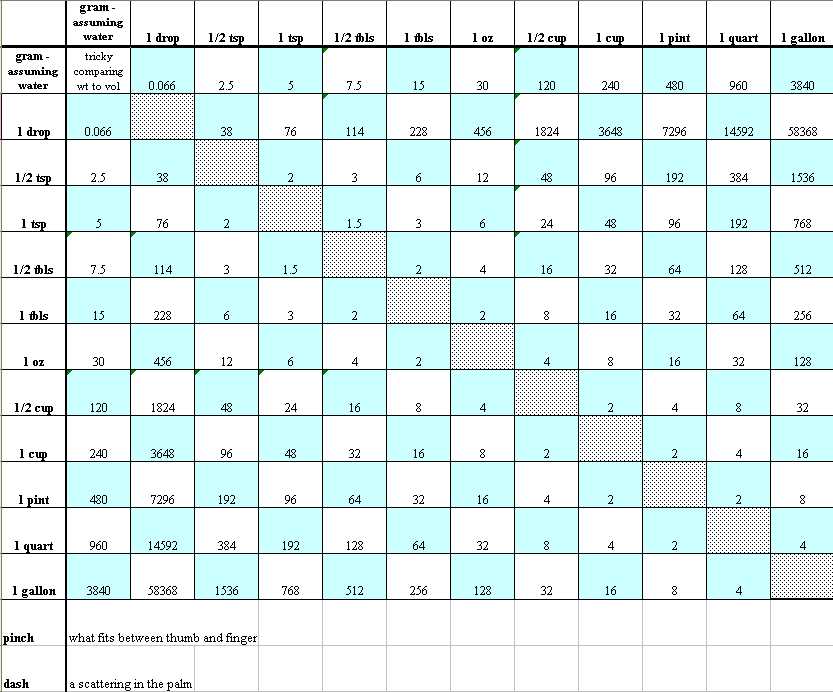 |
 |
 |
 |
 |
 |
 |
| Q & A Tips, Tricks and Things
You did not Know You needed to Know
Conversion Table  BACK TO TOP Spice Preparation First, remember, you can always ADD more spice, but you can not remove
it. Therefore, start with less than what you think you want then taste
and repeat as desired.
There are several ways to prepare and use spices. Heating foods over 170 degrees kills things. Sometimes this is what you want, often it is not what you want. Many people try to cook their food FAST and this brings consequences. The process of cooking is a factor of time vs heat. Often, you can cook at higher temperature for less time or you can cook at lower temperatures for longer times. But, never should you cook at high temperature for a long time. This has an effect on texture and nutrients. Cooking at higher temperatures will cook the outside much faster than the inside, leading to dry and tough meat. With modern people trying to cook FAST, they opt for the high heat and a minimum time (which often becomes to too much time). Using chicken as an example, you might could use 350 degrees for 20 minutes, or 225 degrees for 60 minutes (much better). Slow cooking your meat makes it more tasty, juicy and tender. On a Related Note Regarding Temperature Vegetables are also being killed by most cooks.
Most vegetables are edible WITHOUT cooking. If you have a reason to “cook” them, then usually the best method is to bring water to a boil and add vegetables for a minute or two, then promptly remove from the water. This helps keep them crispy and tasty with much of their nutrients. The next time you order a pizza try this. Order what you want on the pizza but have veggies put on AFTER it comes from the oven. If they look funny at you, then simply point to the salad bar. Reheating Leftovers Ever heat pot roast as a leftover and find you can hardly chew it or
swallow it? Try this.
Tips for Cooking and Using Herbs and SpicesFor most of your leftovers, bring water to a boil in a deep enough pan to cover you food. Then add the food you want to eat, for about a minute or two. Remove and enjoy the succulence. This will work for all meats and vegetables, with few exceptions - like mashed potatoes. Mixing Spice With Food Some foods will simply need to have the spice added by sprinkling or
folding (mixing) into food. Other foods will better if spices are
prepared separately added to the food.
Fowl are an example of preparing the spice separately. After cooking the fowl, use the drippings of the fowl to mix with the spice. Add oil or water as needed or desired. After preparing the spice you can roll the fowl pieces in the spice or use the spice as a dip. Chili and rice are examples of adding the spice to the food and folding (mixing) it together. There is also the method of sprinkling the spice on the food. Remember, spices taste differently when wet or dry. Eggs and potatoes are examples of sprinkling. Baking Soda and Vinegar From your clothes to your dishes to your hair to your body, baking soda
and vinegar may be the best cleaning agents you get use.
While using Dawn dish soap to remove greasy messes, using baking soda will cost less and work beautifully. The difficulty in using baking soda is that does not lather, leaving a trail of where you have washed, and confuses people as to where they have cleaned. The same is true for your hair and body. Rinsing your hair and body with vinegar is refreshing and exfoliating. The smell is NOT a problem as it is gone in minutes. All Oil and Grease are NOT the Same There is some heady research involved in this, so you will have to do
your own research. But, first choice for cooking is coconut oil,
with second choice being olive oil. A must see: The oiling of America
Herbs and Spices are FOOD Treat them as such. Think in terms of putting food on your
spice. The point is, think of using more than a sprinkle.
Salt First, let us make something perfectly clear. As far as you are
concerned, ALL SALT IS SEA SALT. It matters not if it is
separated from seawater, dug from ground pits. Pits are ancient
sea beds, a collection of salt when that sea disappeared long
ago. The only difference in salts is not the salt, but the
surrounding minerals. The minerals are washed or not washed from
the salt. If you buy grey or pink “sea” salt, it merely is not
cleaned of surrounding minerals. If you buy “white” salt, it is
merely cleaned of surrounding minerals.
The salts that have not been cleaned probably do contain desireable minerals, but that may or may not be enough reason to pay extra. When using herbs and spices, remember SALT can be your friend. You can use SALT to enhance flavor and to extend the use of your herbs and spices. If you want to make your spice fit into more servings, then use a little less and a dash of SALT. BE CAREFUL – if you cross the fine line the SALT will ruin the food. Maybe you could rinse it off, but you have to determine that. 170 degrees If you heat vegetable or animal things to over 170 degrees, you kill
bacteria (GOOD and bad). You also will damage or kill other
things of nutrient value. Many people cook meats at around 350 or
so degrees and for WAY TOO long.
Here are a couple examples of needed temperatures for some food: • Beef is cooked after it reaches an internal temperature of 145-160 degrees (depending on rare, med, well) for about 10 minutes. • Chicken is cooked after it reaches an internal temperature of 160-165 degrees for about 10 minutes. If you want to sear whole spice, that might be OK, but not ground spice. Being mindful of the temperatures will keep your oil from being a concern for cancer. Sodium Hypochlorite (Bleach) a short overview
Many people do not understand simple chemistry (and why should they????) and are easily frightened by technical words. If you tell many people that “dihydro monoxide” is rampant in factory and restaraunts and even in their homes, they would agree to ban it. The same would be true if you tell them the same about “sodium chloride”, they would agree to ban it. And again if you tell them about “sodium hypochlorite”, they would agree to ban it. “dihydro monoxide” is WATER “sodium chloride” is table SALT “sodium hypochlorite” is BLEACH Sodium hypochlorite is one of the two elements which makes SALT. The other is sodium, a metal. When sodium and sodium hypochlorite are combine (do not try this at home) the result is sodium chloride – SALT. Conversely, when you separate SALT into its parts, you get sodium and sodium hypochlorite - BLEACH The promoted fears for bleach may be genuine, but you can drown in water. Should we avoid water? Vinegar will NOT kill Listeria. Exposing something to sodium hypochlorite for at least 3 minutes and as long as 10 minutes will effectively rid it of all germs (bacteria, virus, etc). Sodium hypochlorite once exposed to air is neutralized after about ½ hour to 1 hour, and no longer useful. The remaining residue is sodium (salt), which rinses easily. If you use sodium hypochlorite to disinfect something, including food, it should be adequately rinsed. Typical ratio of use is about 1 cap (1/4oz) bleach to 1 gallon water. This is not a critical ratio. The smell of bleach is NOT bad. It indicates the item is treated and germ free. Deer Meat When using game meat such as deer – it is a very DRY meat. It may
help to include some cow fat added to the deer meat. Maybe 25 %
fat, (maybe 1 lb of venison, and 1/2 lb of cow meat [for fat content]),
otherwise your results will be dry. Experiment.
To Butter or Not to Butter This is closely related to the oil issue. Butter is GOOD for
you.
Ants and flies will not touch margarine. It is hydrogenated and causes heart disease. AND it does not spoil. But having said all that, coconut oil is a great replacement for butter.
Why Cook Food That is a trick question. If it is food, you do not need to cook
it. If it is something you can not eat in the raw, then heating
it helps break down elements of the item so you can digest it. As
a rule, raw vegetables are usually food right off the plant. They
do not need “cooking”. Have you ever eaten a tomato off the
vine? What of corn? You have never really tasted them till
you eat them fresh from the plant.
BACK TO TOP |
|
DISCLAMER: All
content and item descriptions via BillyGoatMountain.net
(BGM) are for educational purposes. You
should do your own due diligence of research and advice from what ever
authority you choose. Do not use any information from BGM
alone to diagnosis or
treat a health problem or disease. Information and statements provided
by
BGM, written or
verbal, are not presented as having been evaluated by the FDA (or other
agency)
and are not, without your own due diligence, intended to diagnose,
treat, cure
or prevent any health condition or disease. Generally, information via
BGM is a
testimonial of
experiences.If you are experiencing medical
issues, you should contact
your shaman (or
medical health care provider).
|
| HOME | PRODUCTS | RECIPES | LINKS | CONTACT | Q & A © Copyright: BillyGoatMountain.net, 2010-2017. All Rights Reserved. |
